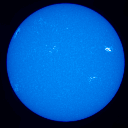





The Sun Now | Compare to Active Sun |
|---|---|
 |
 |
Image Credit: Courtesy of the National Solar Observatory/Sacramento Peak, NOAO. | |
| What layer does the light come from? | |
About the images:Light from singly-ionized calcium ions in the Sun's upper photosphere and chromosphere (up to 2000 km altitude). Because the blue Calcium K Line (393.3 nm) is sensitive to magnetic fields, magnetically active structures show up in high contrast against the surrounding chromosphere. Places where moderate magnetic fields exist show up bright whereas images of high magnetic fields are dark. These images are taken daily by the ESF Spectroheliograph, National Solar Observatory/ Sacramento Peak. |
|
What to look for:In CaK images, you typically see brightness along the edges of large convection cells called supergranules and in areas called plages. Dark sunspots and filaments are also visible. |
|
Connect me to the SOHO image gallery and the SOHO Movie Theater
Connect me to the National Solar Observatory/Sacramento Peak
The source of this material is Windows to the Universe, at http://windows2universe.org/ from the National Earth Science Teachers Association (NESTA). The Website was developed in part with the support of UCAR and NCAR, where it resided from 2000 - 2010. © 2010 National Earth Science Teachers Association. Windows to the Universe® is a registered trademark of NESTA. All Rights Reserved. Site policies and disclaimer.